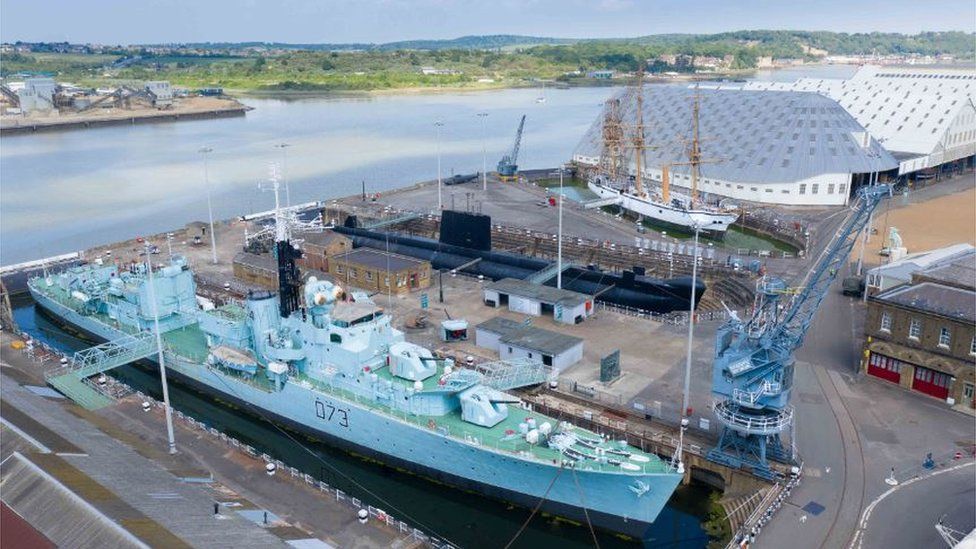Chatham Dockyard: Reinvention of site 40 years after closure
- Published

The reverberations from the closure of one of the UK's last royal shipyards 40 years ago are still being felt.
On 31 March 1984 more than 7,000 skilled workers at Chatham Dockyard lost their jobs, as well as another 10,000 people in supporting industries.
With them went the Kent town's long history of building, repairing and supplying ships for the Royal Navy.
A shocking blow at the time, but some now say the site has reinvented itself "like a phoenix rising from the ashes".
King Charles III, who served in a warship based in Chatham, recently described the dockyard's closure as "a profound challenge".
There had been a dockyard in the Kent town for 400 years. Nelson's HMS Victory was built there.
More than 400 ships were constructed in Chatham, from wooden fighting sailing ships and the age of iron and steam, to 20th Century destroyers and submarines.
At its height during World War Two the dockyard employed 17,000 workers from more than 26 different trades across 700 acres.
At the time of closure in 1984 there were 7,300 people employed on site.
A total of 2,300 received compulsory redundancy, 2,000 were transferred to other naval dockyards, 1,500 retired and 1,500 took voluntary redundancy.
Chatham Dockyard closed as a result of a defence review by the government of Margaret Thatcher which was aimed at reducing expenditure during the early 1980s recession.
Richard Holdsworth, dockyard historian, said 1984 was a pivotal moment for the site.
He said: "When I arrived this was virtually a dead site. The dockyard really was the purpose for Chatham.
"It developed from being a fishing village primarily because the dockyard was there."
He added: "It was a naval town. And the navy left. Chatham was in shock for a very long time."
BBC News reported on the white ensign being lowered for the last time at Chatham Dockyard on 30 September 1983
Mr Holdsworth is former heritage director at the Historic Dockyard, the tourist attraction which moved in when the shipyard closed.
The site of the old naval base was split. It now includes a tourist attraction, a working port, a large housing development, a university complex and a shopping outlet.
The Historic Dockyard Chatham is now one of Kent's largest tourist attractions.
It is made up of more than 100 buildings and structures, 47 of which are scheduled as ancient monuments, plus three historical warships in dry docks.
Mr Holdsworth said: "An awful lot of highly-skilled people took their redundancy and set up small to medium size enterprise companies nearby."
"It has been a phoenix that has risen from the ashes. It's very different now.
"In terms of regeneration the job has been done several times over."
From shipbuilders to volunteer tour guides
"Looking back on it, I loved it," said John de Rose, who became an apprentice shipwright at Chatham aged 16 in 1962.
"We had a good navy. And Chatham was fully used to fit those ships.
"When it closed I thought 'what am I going to do now?'"
Tony Peacock, another apprentice shipwright who joined in 1968, said: "We had a lot of laughs. It was so sad when it closed."
Both men are back at the dockyard as volunteers, helping visitors in the site's photo library and taking round tour parties.
Mr de Rose said: "I love the dockyard. And telling kids about it."
Mr Peacock added: "I have a lot of memories. It was a great place to work."
James Morgan maintains the vessels at The Historic Dockyard Chatham
Keeping traditional skills alive
Alex Rowling, the managing director of Master Ropemakers, has a proud boast.
"We make enough rope every year to reach the moon!" Ms Rowling said.
Her company helps keep the traditional skill of ropemaking alive inside the Historic Dockyard.
The ropery is a quarter of a mile-long building where naval rope has been made commercially since 1618.
Ms Rowling added: "We are here primarily to educate. But the rope we make is sold around the world."
Leanne Clark learned her craft from Fred Cordier, the last master ropemaker at the dockyard before it closed.
She said: "It's not exactly the kind of thing you get at job fairs.
"It's living history - keeping something alive using Victorian equipment.
"I genuinely love me job."
Leanne Clark is a master ropemaker
Lights! Camera! Action!
The dockyard's authentic cobbled streets, industrial buildings and Georgian and Victorian architecture have regularly been the backdrop for film and television productions.
The site has been a filming location for blockbuster Hollywood movies, like Sherlock Holmes, Les Misérables and Mission: Impossible, and also popular television dramas, such as the BBC's Call The Midwife.
Olivia Horner, director of commercial operations, has overseen all those productions.
She said: "We have been welcoming film crews for 40 years now. All the income generated goes back into supporting us as a charity.
"We've had around 15,000 people come on our Call The Midwife tour mainly because we are the iconic location where it is filmed."
"The biggest attraction we offer is our backdrop. Our buildings are just so perfect for period dramas."
Related Topics
- Published14 December 2021
- Published8 August 2019
- Published31 March 2014
- Published31 March 2014
- Published31 March 2014
- Published21 September 2013